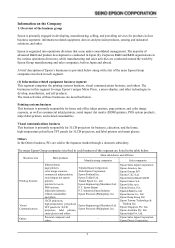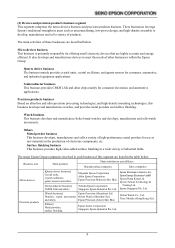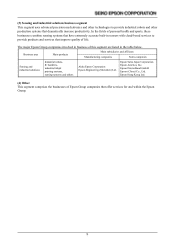Epson 2015 Annual Report Download - page 17
Download and view the complete annual report
Please find page 17 of the 2015 Epson annual report below. You can navigate through the pages in the report by either clicking on the pages listed below, or by using the keyword search tool below to find specific information within the annual report.
16
Risks Related to Epson’s Business Operations
At present, we have identified the following significant factors as risks that could have a materially adverse
effect on our future business, financial condition or operating results and that should thus be taken into account
by investors. There may be other risk factors of which we are unaware at this time. We strive to recognize,
prevent, and control potential risks and to address risks that materialize. Also, all forward-looking statements
hereunder were made at Epson’s discretion as of the date this Annual Report was submitted.
1. Our financial performance could be adversely affected by fluctuations in printer sales.
The ¥907.2 billion in revenue in the information-related equipment segment in the year ended March 31, 2015
accounted for more than 80% of Epson’s consolidated revenue of ¥1,086.3 billion. Inkjet printers (including
printer consumables) for the home, emerging markets, as well as for office, commercial, and industrial
applications accounted for a large majority of our revenue and profit. Consequently, a decrease in revenue from
printers and printer consumables could have a materially adverse effect on our operating results.
2. Our financial performance could be adversely affected by competition.
Adverse effects of competition on sales
All of our products, including our core printer and projector products, are subject to the effects of vigorous
competition, which could cause, among other things, prices to fall, demand to shift toward lower-priced
products, and unit shipments to decline.
We are taking strategic action to address the risk of such declines in prices and unit shipments. On one hand, we
must provide products tailored to customer needs in each market along with high-value products and services.
On the other hand, we must reduce manufacturing costs by increasing design and development efficiency and
by reducing fixed costs.
However, there is no assurance we will succeed in these efforts, and if we are unable effectively to counteract
downward pressure on prices, our operating results could be adversely affected.
Adverse effects of competition on technology
Some of the products that we sell contain technology that places Epson in competition against other companies.
For example:
- The Micro Piezo technology1 that we use in our inkjet printers competes with the thermal inkjet
technologies2 of other companies;
- The 3LCD technology3 that we use in our projectors competes with other companies’ DLP technologies4.
We believe that the technologies we use in these products are superior to the alternative technologies of other
companies. However, if consumer opinion with respect to our technologies changes, or if other revolutionary
technologies appear on the market and compete with our technologies, we could lose our competitive advantage
and our operating results could be adversely affected.
1Micro Piezo technology is an inkjet technology created by Epson that manipulates piezoelectric elements to fire small
droplets of ink from nozzles.
2Thermal inkjet technology (also known as bubble-jet technology) is a printer technology in which the ink is heated to create
bubbles and the pressure from the bubbles is used to fire the ink.
33LCD technology uses high-temperature polysilicon TFT liquid-crystal panels as light valves. The light from the light source
is divided into the three primary colors (red, blue and green) using special mirrors, the picture is created on separate
LCDs for each color, and then the picture is recombined without loss and projected on the screen.
4DLP technology uses a digital micro-mirror device (DMD) as a display device. A DMD is a semiconductor on which a large
number of micro mirrors are arranged, each mirror directing light onto its own individual pixel. An image is formed by
the light from the light source being reflected from the mirrors onto the screen. DLP and DMD are registered trademarks
of Texas Instruments Incorporated.
The emergence of new competitors
We presently face competition from powerful companies that have advanced technological capabilities,
abundant financial resources, or strong financial compositions. We also face competition from companies
around the world that have market recognition, strong supply capacities, or the ability to compete on price.
There is, therefore, a possibility that other companies could use their brand power, technological strength,
























